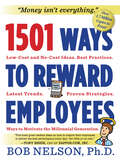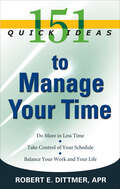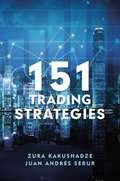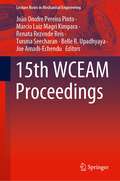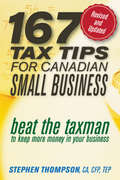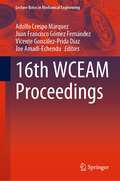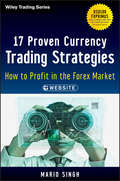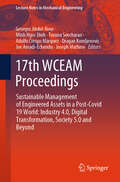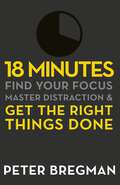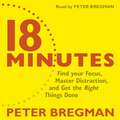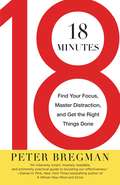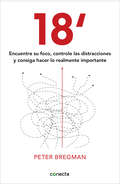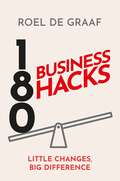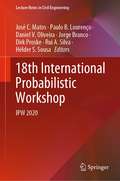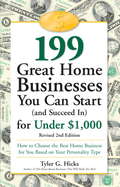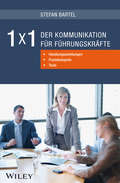- Table View
- List View
1501 Ways to Reward Employees
by Bob NelsonToday more than ever, businesses need fresh ideas to nurture talent and retain employees—enter 1,501 Ways to Reward Employees, thoroughly revised, updated, and even more chockablock with ideas than 1,001 Ways to Reward Employees, the groundbreaking national bestseller.Adapted to meet the needs of an evolving workplace—especially to deal creatively with virtual employees, freelancers and permalancers, international colleagues, and the rule-bending expectations of millennials—its 1,501 low-and no-cost rewards and strategies are drawn from thousands of companies across the globe. Ideas range from the informal (Wells Fargo’s thank-you e-cards) and the offbeat (JS Communications two free “I Don’t Want to Get Out of Bed” Days) to the formal (J. C. Penney “affirms” new managers in a moving ceremony) to the totally nutty (the legendary honor of having your office “sodded”—literally, grassed over—at Microsoft). For bosses, managers, entrepreneurs, small-business owners, consultants—anyone who’s responsible for working successfully in an ever-tougher economy—this is the rewards bible.
151 Quick Ideas to Manage Your Time (151 Quick Ideas)
by Robert E. DittmerTime management: We’re doing it wrong. Now discover real-world, tried-and-tested solutions to free yourself from the frenzy!Too many of us live our lives trying to shoehorn our many activities and responsibilities into too few time slots available. Managing our calendars and keeping a close eye on the clock becomes an all-consuming chore in itself—and the stress can cause our job performance and relationships to suffer.This book presents 151 quick and easy ways to more effectively meet these challenges in our daily lives. Take a breath, and benefit from the ideas and hard-earned wisdom of people just like you—among them:• Start Your Day the Night Before• Undercommit and Overdeliver• Organize Your Workspace• Block Contingency Time Every Day• Discourage “War Stories”• Use Copy and Paste• Fight Spam with an E-mail Blocker• Don’t Check Your Portfolio Constantly, and many more
151 Trading Strategies
by Zura Kakushadze Juan Andrés SerurThe book provides detailed descriptions, including more than 550 mathematical formulas, for more than 150 trading strategies across a host of asset classes and trading styles. These include stocks, options, fixed income, futures, ETFs, indexes, commodities, foreign exchange, convertibles, structured assets, volatility, real estate, distressed assets, cash, cryptocurrencies, weather, energy, inflation, global macro, infrastructure, and tax arbitrage. Some strategies are based on machine learning algorithms such as artificial neural networks, Bayes, and k-nearest neighbors. The book also includes source code for illustrating out-of-sample backtesting, around 2,000 bibliographic references, and more than 900 glossary, acronym and math definitions. The presentation is intended to be descriptive and pedagogical and of particular interest to finance practitioners, traders, researchers, academics, and business school and finance program students.
15th WCEAM Proceedings (Lecture Notes in Mechanical Engineering)
by Joe Amadi-Echendu João Onofre Pereira Pinto Marcio Luiz Magri Kimpara Renata Rezende Reis Turuna Seecharan Belle R. UpadhyayaThis book gathers selected peer-reviewed papers from the 15th World Congress on Engineering Asset Management (WCEAM), which was hosted by The Federal University of Mato Grosso do Sul Campo Grande, Brazil, from 15–-18 August 2021This book covers a wide range of topics in engineering asset management, including: strategy and standards;sustainability and resiliency;servitisation and Industry 4.0 business models;asset information systems; andasset management decision-making. The breadth and depth of these state-of-the-art, comprehensive proceedings make them an excellent resource for asset management practitioners, researchers, and academics, as well as undergraduate and postgraduate students.
167 Tax Tips for Canadian Small Business: Beat the Taxman to Keep More Money in Your Business
by Stephen Thompson"...a book for every Canadian in a small or home-based business who is struggling with complex tax rules and regulations." —Dale Ennis, Canadian MoneySaver "...easy-going style and avoidance of the more mind-numbing details make for a solid primer on the perks and pitfalls of self-employment. The...one-sentence tips in the appendix are probably worth the price of admission alone." —Gordon Powers, The Globe and Mail "...one of the better books I've seen on the market for small-business owners and better yet, it's all Canadian content." —Linda A. Fox, The Toronto Sun As a small-business owner or a home-based entrepreneur, you have lots of questions about taxes, but very few answers. Fortunately for you, 167 Tax Tips for Canadian Small Business contains a wealth of tax planning advice and strategies to help you save on your business tax bill. So whether you want to do it yourself or reduce what you pay your accountant - not to mention the government - this is how you'll keep more money in your pocket, where it belongs. Packed with tax tips that will save you hundreds, or even thousands, of dollars year-round. Written in a question-and-answer format that's easy to understand, practical, and easy to apply. Features 167 "Tax Beaters" - quick-reference tips that highlight key points - plus three bonus tips to help you save even more! Explains how to save taxes in every aspect and at every stage of your business. Features a Year-Round Tax-Planning Calendar. Coverage includes: business start-up, corporate tax planning, GST/HST, deductibility of home and automobile expenses, what to do if you are audited by the Canada Revenue Agency, CPP and QPP deductions for self-employed entrepreneurs, and much more. The ultimate "tax coach" for every Canadian in a small or home-based business, this book will help you to beat the taxman at his own game!
168 Hours: You Have More Time Than You Think
by Laura VanderkamThere are 168 hours in a week. This book is about where the time really goes, and how we can all use it better. It's an unquestioned truth of modern life: we are starved for time. With the rise of two-income families, extreme jobs, and 24/7 connectivity, life is so frenzied we can barely find time to breathe. We tell ourselves we'd like to read more, get to the gym regularly, try new hobbies, and accomplish all kinds of goals. But then we give up because there just aren't enough hours to do it all. Or else, if we don't make excuses, we make sacrifices. To get ahead at work we spend less time with our spouses. To carve out more family time, we put off getting in shape. To train for a marathon, we cut back on sleep. There has to be a better way-and Laura Vanderkam has found one. After interviewing dozens of successful, happy people, she realized that they allocate their time differently than most of us. Instead of letting the daily grind crowd out the important stuff, they start by making sure there's time for the important stuff. They focus on what they do best and what only they can do. When plans go wrong and they run out of time, only their lesser priorities suffer. It's not always easy, but the payoff is enormous. Vanderkam shows that it really is possible to sleep eight hours a night, exercise five days a week, take piano lessons, and write a novel without giving up quality time for work, family, and other things that really matter. The key is to start with a blank slate and to fill up your 168 hours only with things that deserve your time. Of course, you probably won't read to your children at 2:00 am, or skip a Wednesday morning meeting to go hiking, but you can cut back on how much you watch TV, do laundry, or spend time on other less fulfilling activities. Vanderkam shares creative ways to rearrange your schedule to make room for the things that matter most. 168 Hours is a fun, inspiring, practical guide that will help men and women of any age, lifestyle, or career get the most out of their time and their lives.
16th WCEAM Proceedings (Lecture Notes in Mechanical Engineering)
by Adolfo Crespo Márquez Vicente González-Prida Díaz Joe Amadi-Echendu Juan Francisco Gómez FernándezThis book gathers selected peer-reviewed papers from the 16th World Congress on Engineering Asset Management (WCEAM), held in Seville from 5–7 October 2022. This book covers a wide range of topics in Engineering Asset Management, including: Asset management and decision support system Industry 4.0 tools and its impact on asset management Monitoring, diagnostics and prognostics for smart maintenance Asset life cycle management Asset management in the industrial sector Human dimensions and asset management performance Infrastructure Asset management Asset condition, risk, resilience, and vulnerability assessments Asset operations and maintenance strategies Reliability and resilience engineering Applications of international and local guidelines and standards The breadth and depth of this state-of-the-art, comprehensive proceedings make it an excellent resource for asset management practitioners, researchers and academics, as well as undergraduate and postgraduate students.
17 Proven Currency Trading Strategies
by Mario SinghCountless money-making opportunities abound in the Foreign Exchange (Forex) market every day, but how does an amateur investor take advantage of these opportunities to earn high returns? This book by CNBC-featured Forex Expert Mario Singh provides a comprehensive solution to this question.Following the first section that explains in plain English--what is Forex trading, how money is made in the Forex "game," the six major players involved, and the importance of knowing one's Trader Profile--the second section focuses on specific and practical guidance which includes:A "Trader Profile Test" to help the reader get a clear picture of his natural trading style and which of five trading profiles he belongs to (Scalper, Day Trader, Swing Trader, Position Trader or Mechanical Trader)17 proven trading strategies (between 2 to 5 strategies for each trader profile) for the reader to immediately start cashing in on the Forex marketDescriptions of an array of real-world trading scenarios, with tips on how to address themA section that shows the reader how to custom-tailor a trading system designed for his sensibilities and risk toleranceForex hedging strategies for finance professionals at multinational corporationsShort on theory and long on practical insights and step-by-step guidance, 17 Proven Currency Trading Strategies--How To Profit in the Forex Market will help anyone--from beginners to professionals, and everyone in between--to master the Forex market and be consistently profitable.
17th WCEAM Proceedings: Sustainable Management of Engineered Assets in a Post-Covid 19 World: Industry 4.0, Digital Transformation, Society 5.0 and Beyond (Lecture Notes in Mechanical Engineering)
by Joseph Mathew Adolfo Crespo Márquez Joe Amadi-Echendu Dragan Komljenovic Turuna Seecharan Georges Abdul-Nour Minh Ngoc Dinh17th WCEAM Proceedings provides a record of some of the intellectual discussions (including keynote addresses, research paper presentations, panel debates and practical workshops) that took place among the attendees and participants of the 17th World Congress on Engineering Asset Management (WCEAM), held from 18 - 20 October 2024 at the Sheraton Saigon Hotel and Towers, Ho Chi Minh City, Vietnam. The events were organized by the International Society for Engineering Asset Management (ISEAM) and hosted by RMIT University Vietnam LLC (RMIT VN), Ho Chi Ming City. The content of the book includes topics listed below under a general theme of Sustainable Management of Engineered Assets in a Post-Covid World: Industry 4.0, Digital Transformation, Society 5.0 and beyond Sustainable asset investment, acquisition, operations, maintenance, and retirement strategies Production-service transformation and product-service systems Sustainable asset acquisition, operations, maintenance, and retirement processes Modeling and simulation of acquisition, operations, maintenance, and retirement processes Reliability and resilience engineering Applications of the Fourth Industrial Revolution (4IR) technologies in EAM, e.g., Digital Twins Cybersecurity issues in asset management Asset condition, risk, resilience, and vulnerability assessments Asset management and decision support systems Applications of international and logical guidelines and standards in EAM Human dimensions and asset management performance Case studies of asset management in various industries and sectors This proceedings is an excellent resource for asset management practitioners, researchers and academics, as well as undergraduate and postgraduate students.
18 Minutes: Find Your Focus, Master Distraction and Get the Right Things Done
by Peter BregmanThe most important business/self-help book since EMOTIONAL INTELLIGENCE and THE ONE-MINUTE MANAGER.How often do you get to the end of another long and frantic day and wonder why so many important things didn't get finished? We've never worked so hard and felt so unproductive and unfulfilled. 18 MINUTES takes this challenge and turns it on its head. Peter Bregman, top HARVARD BUSINESS REVIEW columnist and global management consultant, shatters the myth of getting it all done by offering a clear and simple plan for getting the right things done. He shows how the best way to fight distracting interruptions is to create productive ones ourselves, a practice that can be easily implemented in 18 minutes a day. The result is a simple yet comprehensive approach to managing your life a year, a day, and a moment at a time so that your life moves forward the way you want and at the pace you want.
18 Minutes: Find Your Focus, Master Distraction and Get the Right Things Done
by Peter BregmanHow often do you get to the end of another long and frantic day and wonder why so many important things didn't get finished? We've never worked so hard and felt so unproductive and unfulfilled. 18 MINUTES takes this challenge and turns it on its head. Peter Bregman, top HARVARD BUSINESS REVIEW columnist and global management consultant, shatters the myth of getting it all done by offering a clear and simple plan for getting the right things done. He shows how the best way to fight distracting interruptions is to create productive ones ourselves, a practice that can be easily implemented in 18 minutes a day. The result is a simple yet comprehensive approach to managing your life a year, a day, and a moment at a time so that your life moves forward the way you want and at the pace you want.Written and read by Peter Bregman(p) 2011 Hachette Audio
18 Minutes: Find Your Focus, Master Distraction, and Get the Right Things Done
by Peter BregmanBased upon his weekly Harvard Business Review columns (which is one of the most popular columns on HBR.com, receiving hundreds of thousands of unique page views a month), 18 MINUTES clearly shows how busy people can cut through all the daily clutter and distractions and find a way to focus on those key items which are truly the top priorities in our lives. Bregman works from the premise that the best way to combat constant and distracting interruptions is to create productive distractions of one's own. Based upon a series of short bite-sized chapters, his approach allows us to safely navigate through the constant chatter of emails, text messages, phone calls, and endless meetings that prevent us from focusing our time on those things that are truly important to us. Mixing first-person insights along with unique case studies, Bregman sprinkles his charming book with pathways which help guide us -- pathways that can get us on the right trail in 18 minutes or less.
18 minutos: Encuentre su foco, controle las distracciones y consiga hacer lo importante
by Peter BregmanEl método para lograr concentrarse en aquello que es realmente prioritario para usted. ¿No siente con frecuencia que llega al final de su jornada agotado, pero sin haber avanzado en ninguna de las tareas que se había fijado como prioridades en su trabajo o en su vida personal? 18 minutos plantea la solución que le permitirá eliminar las constantes distracciones del día a día y concentrarse en aquellas actividades que le resultan realmente importantes. El autor parte de la premisa de que la mejor fórmula para luchar contra las constantes interrupciones es crear nuestras propias distracciones productivas. Estructurado en breves capítulos, el libro enseña una estrategia que nos permitirá navegar sin naufragar por el continuo flujo de correos electrónicos, mensajes, llamadas y reuniones que nos impiden dedicar nuestro tiempo a todo aquello que es realmente importante para nosotros... con invertir tan solo 18 minutos cada día. Reseñas:«18 minutos es una guía verdaderamente inteligente, asequible y, sobre todo, muy práctica, y que contribuirá a potenciar su eficacia y a incrementar su satisfacción. Yo lo he comprobado en mi propio trabajo. Usted también lo notará.»Daniel H. Pink, autor del best seller Una nueva mente «Sentir que mantenemos el control sobre cómo empleamos nuestro tiempo es un factor clave para alcanzar la felicidad. En este libro ameno y práctico, Peter Bregman nos muestra cómo disponer de tiempo suficiente para hacer las cosas que realmente nos importan, de tal forma que nuestra vida se convierta en un reflejo de nuestros valores y prioridades.»Gretchen Rubin, autora del best seller Objetivo: felicidad «Lea este libro. La sabiduría de su autor, su humildad y su capacidad para narrar impregnan cada página. 18 minutos es la mejor combinación entre un libro de empresa y uno de superación personal.»Robert Sutton, profesor de la Universidad de Stanford y autor de Buen jefe, mal jefe
180 Business Hacks: Little Changes, Big Difference
by Roel de Graaf180 OF THE SHARPEST AND STICKIEST WAYS TO GET BETTER RESULTS AT WORK"Flip the org chart and put the customer on top." "Write the press release before you start development." "Give someone busy more work to do." In 180 Business Hacks, you'll find these and 177 other surprising, sharp and inspiring ways to get better results at work. These cheat codes will help you succeed by shifting the way you think about business problems. Conventional thinking gets you conventional results but often the stickiest ideas are small. And like tiny cracks, they eventually turn into in something bigger. The hacks are organized into 9 themed chapters (Innovation, Strategy, Structure, Management, Analysis, Portfolio, Change, Impact and Effectiveness) so you can find them quickly, but for best results just flip through and open at random. You'll always find something unexpected to add to your daily routine.
180 Business Hacks: Little Changes, Big Difference
by Roel de Graaf180 OF THE SHARPEST AND STICKIEST WAYS TO GET BETTER RESULTS AT WORK"Flip the org chart and put the customer on top." "Write the press release before you start development." "Give someone busy more work to do." In 180 Business Hacks, you'll find these and 177 other surprising, sharp and inspiring ways to get better results at work. These cheat codes will help you succeed by shifting the way you think about business problems. Conventional thinking gets you conventional results but often the stickiest ideas are small. And like tiny cracks, they eventually turn into in something bigger. The hacks are organized into 9 themed chapters (Innovation, Strategy, Structure, Management, Analysis, Portfolio, Change, Impact and Effectiveness) so you can find them quickly, but for best results just flip through and open at random. You'll always find something unexpected to add to your daily routine.
18th International Probabilistic Workshop: IPW 2020 (Lecture Notes in Civil Engineering #153)
by Dirk Proske Paulo B. Lourenço Jorge Branco José C. Matos Daniel V. Oliveira Rui A. Silva Hélder S. SousaThis volume presents the proceedings of the 18th International Probabilistic Workshop (IPW), which was held in Guimarães, Portugal in May 2021. Probabilistic methods are currently of crucial importance for research and developments in the field of engineering, which face challenges presented by new materials and technologies and rapidly changing societal needs and values. Contemporary needs related to, for example, performance-based design, service-life design, life-cycle analysis, product optimization, assessment of existing structures and structural robustness give rise to new developments as well as accurate and practically applicable probabilistic and statistical engineering methods to support these developments. These proceedings are a valuable resource for anyone interested in contemporary developments in the field of probabilistic engineering applications.
1928 Diagnostics: Fighting Antibiotics Resistance
by Daniela Beyersdorfer Ariel D. SternIn 2019, the co-founders of the Swedish medical start-up 1928 Diagnostics, CEO Dr. Kristina Lagerstedt and COO Dr. Susanne Staaf, had to pick the right business model to commercialize their novel technology to hospitals and health care providers. Developed in partnership with research hospitals to help fight the global antibiotic resistance crisis, the firm's cloud-based technology platform helped partners identify resistant genes and mutations in bacteria more quickly and accurately, allowing for easier outbreak cluster tracking in support of hospital infection control management, as well as better diagnostics and antibiotic selection. By 2019, they had raised $5 million, employed 16 people, and had their tool deployed at 24 partner sites in 10 different countries. Their decisions on which markets to focus on and with which business model would crucially impact the young firm's chances at successfully converting existing users and attracting new clients.
199 Great Home Businesses You Can Start (and Succeed In) for Under $1,000: How to Choose the Best Home Businesses for You Based on Your Personality Type
by Tyler G. HicksTurn Your Dream of Starting a Home-Based Business into Reality! It's incredibly easy to start a money-making business right from the comfort of your own home. Millions of people just like you are enjoying the freedom—and extra income—of working for themselves. You can too. In 199 Great Home Businesses You Can Start (and Succeed In) for Under $1,000, home-based business guru Tyler Hicks shows you how to achieve your work-at-home dream. Inside you'll learn the secrets to: ·Choosing the home-based business that's just right for you ·Getting started in your business with minimal cost ·Building your fortune doing what you love ·Running a business from home while keeping your day job ·Using the Internet to advertise and promote your home-based business ·And much more! This invaluable book will help you begin your promising new life today as a successful home-based entrepreneur! <P><P><i>Advisory: This book offers only partial accessibility. We have kept it in the collection because it is useful for some of our members. Benetech is actively working on projects to improve accessibility issues such as these in the future.</i>
1991 How P. V. Narasimha Rao Made History: How P.v. Narasimha Rao Made History
by Sanjaya BaruP. V. Narasimha Rao (or PV as he was popularly known) has been widely praised for enabling the economic reforms that transformed the country in 1991. From the vantage point of his long personal and professional association with the former prime minister, bestselling author Sanjaya Baru shows how PV’s impact on the nation’s fortunes went way beyond the economy. This book is an insider’s account of the politics, economics and geopolitics that combined to make 1991 a turning point for India. The period preceding that year was a difficult one for India: economically, due to the balance of payments crisis; politically, with Rajiv Gandhi’s politics of opportunism and cynicism taking the country to the brink; and globally, with the collapse of the Soviet Union, its ally. It was in this period that the unheralded PV assumed leadership of the Indian National Congress, took charge of the central government, restored political stability, pushed through significant economic reforms and steered India through the uncharted waters of a post-Cold War world. He also revolutionized national politics, and his own Congress party, by charting a new political course, thereby proving that there could be life beyond the Nehru-Gandhi dynasty. 1991 marked the end of an era and the beginning of another. It was the year that made PV. And it was the year PV made history.
1994-95 Mexican Peso Crisis
by Kenneth A. Froot Matthew McbradyExplores the peso crisis of 1994-95 and why it occurred. Students must examine Mexico's policies, the capital market's reactions, and the implications of devaluation for future capital flows and growth.
1996 Welfare Reform in the United States
by Matthew C. Weinzierl Katrina Flanagan Alastair SuOn August 22, 1996, U.S. President Bill Clinton signed into law the Personal Responsibility and Work Opportunity Reconciliation Act (PRWORA)-a dramatic reform of the American system of economic assistance for the poor that, as its title suggested, attempted to encourage labor force participation rather than reliance on federal support. Clinton's decision to support a proposal that substantially cut spending on economic assistance was controversial among members of the Democratic Party, especially so close to the 1996 election. Republicans, in contrast, hailed the signing of PRWORA. Was the 1996 welfare reform a triumph of centrist policymaking that would establish a more sustainable version of economic assistance for poor Americans, or was it a dangerous first step toward the gradual disappearance of that assistance? Whose vision of American society did it represent? Instructors may also obtain a Teaching Note, written by this case's author, that provides suggestions for using this case effectively in the classroom.
1worker1vote: MONDRAGON in the US
by Rebecca Henderson Michael NorrisMONDRAGON, the largest cooperative in the world, and the inspiration for several U.S. cooperatives, faces a challenge in 2013 after one of its largest cooperatives votes to leave the group and another goes bankrupt.
1worker1vote: MONDRAGON in the US
by Michael Norris Rebecca M. HendersonMONDRAGON, the largest cooperative in the world, and the inspiration for several U.S. cooperatives, faces a challenge in 2013 after one of its largest cooperatives votes to leave the group and another goes bankrupt.
1x1 der Kommunikation für Führungskräfte: Handlungsanleitungen, Praxisbeispiele, Tools
by Stefan BartelBusiness Fachbuch Kommunikationstraining für Führungskräfte Kommunikationstrainer Stefan Bartel erklärt, wie Führungskräfte ihre Mitarbeiter erfolgreich beeinflussen, motivieren und leiten.Mit konkreten Anleitungen lernen Führungskräfte und Manager jede Führungssituation, von Beurteilungsgesprächen bis zu Teamsitzungen, erfolgreich zu meistern. Kommunikation
